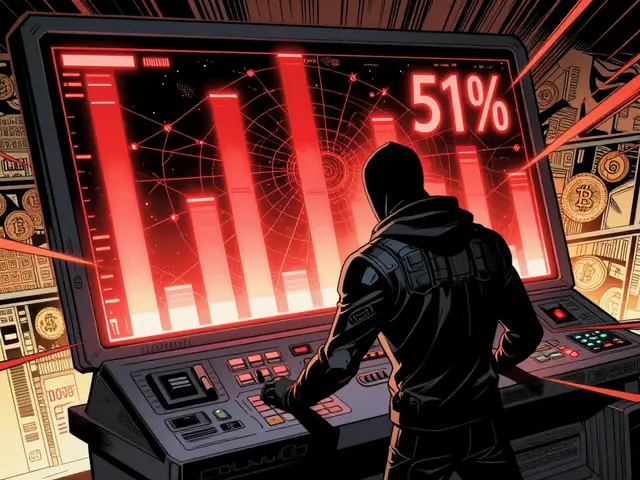Future of Slashing Mechanisms in PoS Blockchains
Slashing Penalty Calculator
Estimate Your Slashing Penalty
Calculate potential penalties for different offenses across major PoS networks based on your staked amount.
When you hear the term slashing mechanisms, think of the invisible security guard that keeps proof‑of‑stake (PoS) networks honest. Over the past few years validators have been penalized for everything from missed heartbeats to deliberately signing conflicting blocks, yet the overall slashing rate stays under a fraction of a percent. Why is that, and what will the next generation of penalties look like? This article walks through the core ideas, current implementations, and the most promising ideas shaping the future of slashing.
What are Slashing Mechanisms?
Slashing mechanisms are a set of on‑chain rules that automatically confiscate a portion of a validator’s staked tokens when the validator breaks predefined protocol rules. The confiscated amount can range from a tiny percentage for brief downtime to the entire stake for a severe offense such as double‑signing. By tying economic loss directly to misbehavior, slashing aligns validator incentives with network health.
In a PoS system, validators lock up a certain amount of the native token as collateral (Proof‑of‑Stake, often abbreviated PoS). This collateral is the “skin in the game” that makes slashing possible: if a validator acts against the protocol, the network can seize part of that skin.
How Slashing Works Today
Most PoS chains define three broad categories of slashable behavior:
- Double‑signing: signing two different blocks for the same slot.
- Surround voting: attesting to a block that “surrounds” another previously attested block, effectively rewriting history.
- Downtime: failing to propose or attest within the required time window.
Let’s see how three leading networks apply these rules.
| Network | Slashable Offenses | Penalty Range | Typical Trigger |
|---|---|---|---|
| Ethereum | Double‑sign, surround vote, prolonged downtime | 0.5% - 100% of stake | Evidence submitted to consensus layer |
| Cosmos (Tendermint) | Double‑sign, equivocation, missed blocks | 5% - 100% of stake | Evidence posted within 2‑hour evidence window |
| Polkadot | Invalid attestations, offline for > 12 hrs, equivocation | 10% - 100% of stake | On‑chain report via governance pallet |
Notice the variation: Cosmos penalizes missed blocks more harshly than Ethereum, while Polkadot uses a tiered approach that can slash up to the full stake after extended offline periods. These differences reflect each chain’s balance between security and validator accessibility.

Economic Impact: Raising the Cost‑of‑Corruption
The primary goal of slashing is to push the cost of an attack beyond any plausible profit. In Byzantine Fault Tolerant (BFT) PoS chains, an attacker typically needs to control at least one‑third of the total voting power to threaten safety. If the network stakes a total of S tokens, the attacker would need roughly 1/3 × S in locked stake.
When a slashing rule targets a single validator, the cost for that validator to misbehave becomes the slashed amount. If the penalty is 50% of the stake, the attacker must be willing to lose half of the locked tokens for every dishonest act. This makes bribery attacks unattractive because the honest chain can broadcast the evidence, trigger slashing, and effectively burn the bribe‑paid validator’s assets.
Real‑world data backs the theory. As of February 2024, Ethereum reported fewer than 0.04% of active validators slashed, and most incidents were accidental configuration errors. The low incidence demonstrates that the economic deterrent works at scale.
Current Challenges and Criticisms
Despite their success, slashing mechanisms face several practical concerns that could shape future designs.
- False positives: Automated detection can sometimes flag benign behavior (e.g., network latency causing a missed heartbeat). Over‑penalizing hurts decentralization by forcing small validators out.
- Validator churn: High slashing rates in early phases can discourage new participants, leading to concentration of stake among a few large operators.
- Complexity of evidence: Submitting proof of misbehavior requires on‑chain transactions that add gas costs and can create bottlenecks during attacks.
- Governance lock‑in: Changing slashing parameters often needs a hard fork, which can be slow and politically fraught.
These pain points are why research communities are exploring more nuanced, adaptive frameworks.

Emerging Trends Shaping the Future of Slashing
Several ideas are gaining momentum. While none are yet universally adopted, they illustrate where the field is headed.
- Adaptive Slashing Ratios: Instead of fixed percentages, protocols could adjust penalties based on validator reputation, network load, or historical uptime. A validator with a strong track record might face a lower penalty for a single missed block.
- Reputation Scores: On‑chain reputation layers (e.g., EigenTrust prototypes) aggregate past behavior into a score that influences slashing severity. This creates a long‑term incentive to maintain consistent performance.
- Hybrid Lock‑Slash Models: Some proposals combine a small, always‑present lock‑up period with a separate, conditional slash. If a validator goes offline, only the lock‑up amount is at risk, while more severe offenses trigger an additional slash.
- Governance‑Driven Parameter Tuning: Using on‑chain voting to adjust slashing thresholds in real time allows the community to respond quickly to emerging attack vectors without a hard fork.
- AI‑Assisted Monitoring: Machine‑learning models could flag anomalous validator patterns before they become slashable events, giving operators a chance to remediate and avoid penalties.
Implementing these concepts requires careful trade‑offs. Over‑softening penalties could erode security, while overly aggressive slashing may push decentralization down the road.
Practical Recommendations for Validators
If you’re running a validator today, consider these actionable steps to stay safe while the ecosystem evolves.
- Maintain Redundant Connectivity: Use at least two geographically distinct internet service providers. Redundancy cuts downtime risk dramatically.
- Automate Key Rotation: Rotate signing keys regularly and store backups offline. This prevents a single key compromise from leading to a massive slash.
- Monitor Evidence Pools: Keep an eye on gossip networks for any reports of double‑signing involving your node. Early detection can let you withdraw stake before a slash is finalised on‑chain.
- Participate in Governance: Vote on slashing parameter proposals. Your input helps shape a balanced penalty regime that protects both security and validator participation.
- Stay Updated on Network Upgrades: Slashing logic often changes with protocol upgrades (e.g., Ethereum’s “Shanghai” upgrade added new evidence windows). Missing a change can lead to unexpected penalties.
By treating slashing as a risk‑management discipline rather than a after‑thought, you’ll protect your stake and contribute to a healthier network.

Looking Ahead: The Next Decade of Slashing
By 2030 we can expect three big shifts:
- Composable Security Modules: Chains will expose pluggable slashing contracts, allowing ecosystems to swap in custom penalty logic without a full network upgrade.
- Cross‑Chain Slashing Coordination: As interoperability grows, a misbehaving validator on one chain could be automatically penalized on another, closing loopholes where attackers hop between networks.
- Regulatory Transparency: Governments may require public audit trails of slashing events, pushing projects to adopt standardized reporting formats that are easier for auditors and users to understand.
Those trends will keep slashing relevant, but the core principle-using economic loss to enforce honest behavior-will stay the same.
Frequently Asked Questions
What triggers a slashing event on Ethereum?
Ethereum slashes validators for double‑signing, surround voting, or prolonged inactivity. Evidence must be submitted to the consensus layer, after which the protocol automatically seizes the prescribed portion of the validator’s stake.
Can a validator recover after being slashed?
Yes. Most networks allow a slashed validator to redeposit the required minimum stake and re‑join the validator set, though they may face higher entry barriers or reduced reputation scores.
How does slashing affect the overall security of a PoS chain?
By making dishonest actions financially painful, slashing raises the cost‑of‑corruption. This discourages attacks, ensures validators act in the network’s best interest, and helps maintain consensus even when a sizable fraction of stake is offline.
Are there alternatives to slashing?
Some projects explore “bond‑burn” models where a validator’s bond is burned only after a formal governance vote, or use reputation‑based incentives without direct token confiscation. However, these alternatives often lack the immediate economic deterrent that slashing provides.
Will future slashing mechanisms become more lenient?
The trend is toward smarter, context‑aware penalties rather than blanket harshness. Adaptive ratios and reputation scores aim to tailor the punishment to the validator’s history, striking a better balance between security and accessibility.









Slashing is essential for keeping validators honest.
The evolution of slashing mechanisms in proof‑of‑stake networks is a subject that demands careful scrutiny, especially as we aim to balance security with validator accessibility. Historically, the punitive measures were binary: either you lost a tiny fraction of your stake for a brief downtime, or you forfeited everything for a grave offense such as double‑signing. However, this simplistic approach fails to account for the nuanced behavior of modern validators who may experience sporadic connectivity issues that are beyond their immediate control. Consequently, the community has begun exploring adaptive slashing ratios that consider a validator’s historical uptime and reputation. By integrating a reputation score, the protocol can impose a lower penalty on a validator with a proven track record, while still deterring malicious actors. Moreover, hybrid lock‑slash models are emerging, wherein a small, always‑present lock‑up amount cushions minor infractions, and a separate, conditional slash addresses severe breaches. This bifurcated strategy reduces the financial shock for honest participants while preserving the deterrent effect against attacks. Governance‑driven parameter tuning further enhances flexibility, enabling on‑chain voting to adjust slashing thresholds in near real‑time without requiring a hard fork. AI‑assisted monitoring tools are also being prototyped to flag anomalous validator patterns before they become slashable events, granting operators a chance to remediate. Nevertheless, these innovations introduce new trade‑offs: excessive leniency could erode the economic disincentive that underpins network security, whereas overly aggressive penalties might centralize stake among large operators. The upcoming decade promises composable security modules, allowing chains to swap slashing contracts without a full network upgrade, and cross‑chain slashing coordination, which would penalize misbehaving validators across multiple ecosystems. Regulatory pressures may also demand greater transparency, pushing projects toward standardized audit trails for slashing events. In summary, while the core principle of using economic loss to enforce honest behavior remains steadfast, the mechanisms will become increasingly context‑aware, reputation‑driven, and interoperable across chains.
Interesting read, good overview; however, I think the article could benefit from more concrete examples, especially regarding how adaptive slashing ratios would be implemented in practice, and also perhaps a comparison with existing reputation systems used in other consensus models.
This whole slashing thing is just a way for big players to keep the lil guys down, and it's getting worse every time they add more layers of "complexity".
sure they say it improves safety but maybe they hide something behind the code
For anyone setting up a new validator, remember to keep an eye on the evidence pool and stay updated on any protocol upgrades; it’s a simple step that can save you a lot of trouble.
Great points! Staying optimistic about these developments is key, and it’s inspiring to see the community push for more balanced security measures.
Nice article, very thorough; I especially like the part about AI‑assisted monitoring-could be a game‑changer.
Let’s keep the momentum going, folks! Every validator who adopts best practices boosts the entire ecosystem.
The future of slashing mechanisms is a tapestry woven from threads of economics, cryptography, and community governance, each demanding careful consideration, yet it is precisely this intricate interplay that can yield resilient systems capable of withstanding both subtle misalignments and overt attacks.
While the prose is expansive, it would benefit from a more structured presentation of the adaptive slashing proposals, perhaps delineating them in a tabular format for clarity.
Honestly, this article sounds like a marketing brochure-too glossy, not enough hard data.
Respectfully, the jargon overload obscures the core message; a clearer lay‑person summary would make these concepts more accessible.
Even though I disagree with some of the premises, I appreciate the attempt to balance security with validator inclusivity-well done.
Wow, another "future‑proof" slashing plan-because we totally need more buzzwords 🙄😂
Too much fluff; get to the point.
Interesting take, though I think the discussion could include more about how cross‑chain slashing might affect validator strategies.
Exactly! We need to vote on these parameters now before the next upgrade rolls out-time’s ticking.
Thank you for providing such a clear and concise overview of slashing mechanisms.
While the content is informative, the lack of citations undermines its academic rigor.